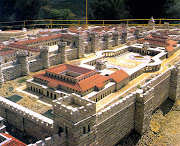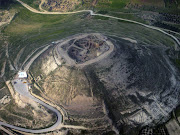In writing an accurately historical account of Herod's time, little questions come up. Today I wondered if he had glass and I found out the answer was YES! Granted it wasn't crystal but it was blown.
Here is the quote I found from the
online bible dictionary is as follows:

The close connection between Egypt and Syria from the time of Thothmes on must have made glass known in the latter country, and the Phoenicians, so apt in all lines of trade and manufacture, naturally seized on glass-making as a most profitable art and they became very proficient in it. The earliest glass was not very transparent, since they did not know how to free the materials used from impurities. It had a greenish or purplish tinge, and a large part of the examples we have of Phoenician glass exhibit this. But we have many examples of blue, red and yellow varieties which were purposely colored, and others quite opaque and of a whitish color, resembling porcelain (Perrot and Chipiez, Art in Ancient Phoenicia and Its Dependencies). But both they and the Egyptians made excellent transparent glass also, and decorated it with brilliant coloring on the surface (ib; Beni Hasan, Archeol. Survey of Egypt, Pt IV). Layard (Nineveh and Babylon) mentions a vase of transparent glass bearing the name of Sargon (522-505 BC), and glass was early known to the Babylonians.
2. Manufacture:

Phoenicia was the great center, and the quantities found in tombs of Syria and Palestine go to confirm the statement that this was one of the great industries of this people, to which ancient authors testify (Strabo, Geog.; Pliny, NH). Josephus refers to the sand of the Belus as that from which glass was made (BJ, II, x, 2). It seems to have been especially adapted for the purpose, but there are other places on the coast where plenty of suitable sand could be obtained. The potash required was obtained by burning certain marine and other plants, and saltpeter, or niter, was also employed. The manufacture began centuries BC on this coast, and in the 12th century AD a factory is mentioned as still being worked at Tyre, and the manufacture was later carried on at Hebron, even down to recent times (Perrot and Chipiez).
Oddly, the Honululu Academy of the Arts is displaying the Kayyem Collection of Ancient Glass and has this to say:

Although glass vessels first appeared in Egypt and Mesopotamia as early as the fifteenth century B.C., glass more widely served general domestic purposes during the Roman period than at any subsequent time or place until the 19th century. The rise of the Roman glassmaking industry roughly coincided with the discovery of glassblowing during the mid first century B.C. The technique revolutionized ancient glass production as its range of shapes and designs were produced so economically that glass became part of every average ancient household. Small glass bottles could have been used to store cosmetics. Large ones could have been tablewares such as cups or pitchers or storage containers. Some glass objects were left in sanctuaries as votive offerings or placed in tombs after their contents had been used to annoint the dead. Glassblown vessels replaced the small core-formed glass bottles and jugs previously made by winding threads of molten glass around a sand or clay core that was removed after the glass had cooled. Glass could be free blown on the end of a blowpipe or blown into a mold for shaping purposes. Roman glassmakers also relied on casting glass with the lost-wax method or by fusing powdered glass under heat in a closed and reusable mold. Pinching, pushing, and pulling still-hot glass with pincers; altering the color of glass by adding certain metal oxides; and applying threads of additional molten glass to existing forms were among the many practices within the Roman glass industry for further decorating their wares.
First century B.C. is right during Herod's lifetime so I'd say it's a go. His father could have had a glass vase with lilies that he knocks over.






